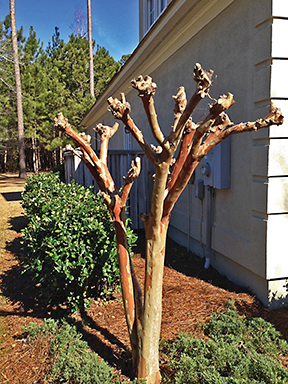Murder in the garden!
Posted on April 30, 2015 by bob in Yard 'N Garden
The familiar crape myrtle we all love in the summer garden was hybridized by breeders at the U.S. Arboretum. The well-known  hybrids named for Native American tribes such as “Natchez”, “Potomac”, or “Choctaw” are easy to propagate, grow fast in the landscape and have become very popular all over the south. These stately beauties are really trees topping out at 20-30 feet, but these crape myrtles were often planted as shrubs, a classic example of the wrong plant in the wrong place. This disconnect between the true nature of the plant and its usage led to what is known as “crape murder”, a drastic cutting of the trunks and branches to keep it in scale in the yard or garden.
hybrids named for Native American tribes such as “Natchez”, “Potomac”, or “Choctaw” are easy to propagate, grow fast in the landscape and have become very popular all over the south. These stately beauties are really trees topping out at 20-30 feet, but these crape myrtles were often planted as shrubs, a classic example of the wrong plant in the wrong place. This disconnect between the true nature of the plant and its usage led to what is known as “crape murder”, a drastic cutting of the trunks and branches to keep it in scale in the yard or garden.
 There is no truth in the idea that drastic pruning of crapes increases the blooms. There is nothing more beautiful in the winter landscape than the graceful branches and exfoliating bark of a well grown crape myrtle. Conversely there is nothing uglier than the short stubby malformed nubs of a “murdered” crape myrtle. A solution to this problem is at hand.
There is no truth in the idea that drastic pruning of crapes increases the blooms. There is nothing more beautiful in the winter landscape than the graceful branches and exfoliating bark of a well grown crape myrtle. Conversely there is nothing uglier than the short stubby malformed nubs of a “murdered” crape myrtle. A solution to this problem is at hand.
Breeders have introduced crapes that range in size from dwarf (3-5 feet) to semi dwarf (5-10 feet) to small tree (10-20 feet), and more new small crapes are on the market every year. The Alabama Cooperative Extension System (ACES) has an excellent publication with a chart listing the crapes by size, name, and color as well as directions for cultivation. To receive this free publication go to aces.edu and search for ANR-1083 under publications.
One way to keep your yard/garden maintenance under control is to remember to read the plant tag when you go to the nursery to determine the eventual size of the plant and what conditions it needs to grow. That charming little shrub may grow into a monster in just a few years that will require constant pruning to keep it in size and may come to resemble something totally differently than what you had envisioned for your landscape.
There are some interesting new series of smaller crape myrtles being developed, the most intriguing being a dark leaved cultivar with leaves ranging from deep red to purple to black. The series is called Delta with the first one named Delta Jazz followed by Breeze, Eclipse, Moonlight and Flame. Ranging in size from 6 to 10 feet high and 4-5 feet wide when mature, they have a better fit in most landscaping plans than the older, larger crape myrtles. The newest plants in this series, Ebony or Black Diamond, were developed from the Delta series to produce a plant with even darker leaves that contrast strongly with lighter colored flowers.
It is somewhat confusing that there are two names for the same crape myrtles, but that is, unfortunately, fairly common in the gardening world. With a mature size of about 8 feet, these, too, could have a place in most landscapes. While I have only seen photos of these crape myrtles, I think the one called Ebony and Ivory or Black Diamond Pure White is quite dramatic with white flowers and almost black leaves. Work is also underway to develop a true dwarf crape myrtle. A series called Razzle Dazzle grows to only 4 feet.
Please note that the crape myrtles in the last paragraph, while available in the market, are not yet fully tested in southern growing conditions. More time and further experience with these new introductions is needed to determine their hardiness and adaptability. Most importantly, do your research on the crape myrtle height and width at maturity before you buy.
Barbara Witt, a Master Gardener since 2010 in the Capital City Master Gardener Association, lives in Montgomery. For information on becoming a master gardener, visit the website, www.capcitymga.org or e-mail capcitymga@gmail.com.
Capital City Master Gardener Association presents FREE LUNCH & LEARN
“Roses for the Faint of Heart”
June 3, 12:00 – 1:00 P.M.
Armory Learning Arts Center, 1018 Madison Avenue, Montgomery
Bring a Sack Lunch – Drinks Provided
For more information contact the Montgomery County Extension Office (334) 270-4133









